Writer: Antoinetta Holierhoek
The SASI and UFV’s Library partnered together in the Langar Project and created a thoughtful exhibit on the history of Langar. Special Collections Librarian Mary-Anne MacDougall arranged the display with a culturally sensitive eye for design and detail.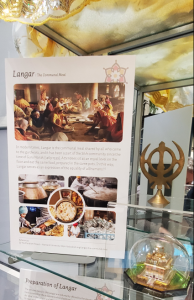
Langar… I’m ashamed to say that I only learned about the deeper meaning of Langar since I started working at the South Asian Studies Institute. You might think, how could you not know? And you’re right, how could I not? Of course, I knew about the distribution of enormous quantities of food being prepared and distributed during catastrophic events or times of need by the Sikh Gurdwaras as the one in November 2021, during the floods. Volunteers of multiple Gurdwaras in the Fraser Valley, Lower Mainland and across BC pulled out all the stops to make sure people stranded by washouts, mudslides and floods didn’t go hungry and gave them hope. Videos of a helicopters and planes being packed to deliver thousands of meals prepared by the volunteers to supply the stranded people in communities like Hope, Merritt and Kamloops were broadcast around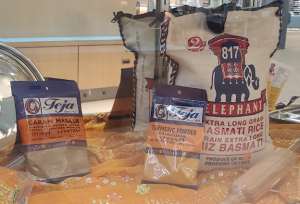 the world.
the world.
I am sharing my newly gained knowledge with the readers of this blog. Langar is originally a Persian word meaning almshouse. Guru Nanak, the first Guru (teacher) and founder of Sikhism (1469-1539) offered free meals to everyone regardless of their caste, gender or wealth in places where people gathered for instruction and discourse.
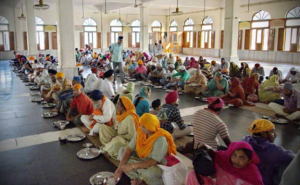
According to Guru Nanak’s teachings, the 3 pillars of the Sikh religion can be summed up in 3 words, Meditate, Work, Give (Japo, Kirat Karo and Vand Chako). Those teachings set the foundation of serving humanity and serving community that have now spread worldwide through Langar.
Guru Angad Dev Ji, the second of the ten Gurus of Sikhism (1504-1552), systemized the institution of Langar in all Sikh Gurwaras and when Guru Amar Das was the Sikh leader (1479-1574) Langar became a prominent institution where people would gather and eat together, also preparing and serving Langar to people outside the Gurdwara.
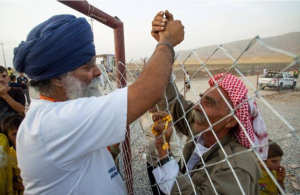 The Langar has proven to be life-saving for a lot of people, but it is also a life-sculpting practise for the Sikh community, not just serving but also preparing Langar is an important practise of ‘Sewa’ (service). Especially on occasions like Gurpurab, the Sikh festival celebrating the birth anniversary of Guru Nanak Dev Ji, Baisakhi, the festival celebrating the establishment of the Khalsa Panth by the tenth Guru Gobind Singh in 1699, families gather at their local gurudwaras to prepare the meals for the community. Once the Langar is ready a small portion of each of the items is placed in front of the Sikh Holy Scripture and a prayer (the Ardaas) is performed. The volunteers serve the visitors that sit in pangat (equally in a row) in the Langar Hall. Once everyone has received their meal, one of the volunteers will call ‘Jo Bole So Nihal’ (Whoever Responds Shall Be Fulfilled) to which the congregation responds with ‘Sat Sri Akal’ (True is the Name of the Great Creator) partaking of the simple, fresh, and vegetarian meal.
The Langar has proven to be life-saving for a lot of people, but it is also a life-sculpting practise for the Sikh community, not just serving but also preparing Langar is an important practise of ‘Sewa’ (service). Especially on occasions like Gurpurab, the Sikh festival celebrating the birth anniversary of Guru Nanak Dev Ji, Baisakhi, the festival celebrating the establishment of the Khalsa Panth by the tenth Guru Gobind Singh in 1699, families gather at their local gurudwaras to prepare the meals for the community. Once the Langar is ready a small portion of each of the items is placed in front of the Sikh Holy Scripture and a prayer (the Ardaas) is performed. The volunteers serve the visitors that sit in pangat (equally in a row) in the Langar Hall. Once everyone has received their meal, one of the volunteers will call ‘Jo Bole So Nihal’ (Whoever Responds Shall Be Fulfilled) to which the congregation responds with ‘Sat Sri Akal’ (True is the Name of the Great Creator) partaking of the simple, fresh, and vegetarian meal.
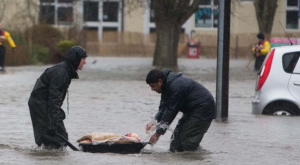 Langar is served by many Sikh charities during challenging situations, for example after the earthquake in Nepal, to refugees in the Middle East, homeless people in North Americ
Langar is served by many Sikh charities during challenging situations, for example after the earthquake in Nepal, to refugees in the Middle East, homeless people in North Americ
a and Europe, flood victims in India, to even serving Langar in a train with Ukrainians fleeing their county, and the list is endless. These are just a few recent examples. Serving Langar has become a multi-faith multicultural experience and it is now that people from a variety of backgrounds are serving Langar to serve the community.
Please visit the SASI and UFV’s library exhibit The Langar Project online or in person at UFV’s Library. Check out the Langar Recipes on the last page of the online exhibit!
Photos: credit for the last 3 photos of this blog, Seeking Wisdom – a Blog by Dr Harbans Lal

